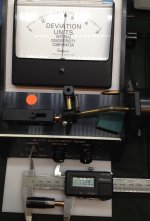For those of you who have tested in the past or may plan to test in the future, you need to isolate the bullet imbalance caused by the Cg (Center of Gravity) offset.
To do that, it's mandatory that the Cg offset be indexed in the chamber so that the imbalanced bullets are fired with the index positions 180 deg's apart. I guess you don't necessarily have to have the indexes at 180 deg's, but that's the easiest method and the best way to measure the dispersion if you don't have the tools I employ in my testing.
If you don't index the round in the chamber, the increased dispersion becomes random in regards to its location and it will be difficult if not impossible to fire enough shots to prove or disprove the validity of any measuring device that purports to measure the imbalance.
Come to think of it, the concentricity of jackets and the skill of custom bullet makers has evolved so much over recent years that you may still have some difficulty in proving the concept, but it's your best shot (pun intended).
That aside, there is no doubt whatsoever imbalanced bullets are a major source of dispersion as per Harold Vaughn's "Rifle Accuracy Facts" and I've duplicated Vaughn's testing of this subject many times in the past.
For those of you who are lucky enough to have a copy of "Rifle Accuracy Facts", Vaughn even gives you the formulas needed to know exactly where the bullet impacts based on where it's indexed and the amount of offset.
To illustrate the concept and methodology, let me present the following. Granted, it's with rimfire and not centerfire, but it's still simple physics and every single one of you with any curiosity can duplicate it in centerfire.
Rail-Gun with Stiller 2500X/Muller 4MI barreled action. Shot in my ballistic tunnel on 3/2/16, but I've performed similar testing several times over the years.
20 bullets with 0.65 grains removed by drilling a hole to cause a Cg offset.
 Drill a
Drill a by
Larry Landercasper, on Flickr
After mounting the barreled action, I aimed at bull #23 and fired 5 shots using "NO" shots with a Cg offset induced by drilling holes (Group 1 on the target below).
The scope was adjusted to move the POI to bull #23 and 5 more shots were fired again with "NO" Cg offset (Group 2).
POA was moved to the center dot on bull #13 and the following methodology was used:
5 shots with the Cg offset indexed in the chamber @ 12:00 were fired and the POI was at 3:00 (Group 3).
5 shots @ 9:00 = 12:00 Impact (Group 4).
5 shots @ 3:00 = 6:00 Impact (Group 5).
5 shots @ 6:00 = 9:00 Impact (Group 6).
 Target a
Target a by
Larry Landercasper, on Flickr
A closer look with some notes I made:
 Target bb
Target bb by
Larry Landercasper, on Flickr
An Excel scattershot chart generated from the x,y point coordinates provided by my electronic targeting software. The chart on top shows every point of impact and the chart on bottom is the calculated and exact mathematical center for each group:
 Dispersion
Dispersion by
Larry Landercasper, on Flickr
I don't know if my comments will generate any interest or questions, but be aware I have a very busy schedule and it's quite possible I won't find the time to address anything I've said.
Landy
PS I thought it might be helpful to add the following from "Rifle Accuracy Facts".
I've done a little editing to hopefully make it a little clearer, but it's pretty much verbatim for what Harold Vaughn says in his book for those of you who don't have a copy:
“An offset Cg (Center of Gravity) is forced to rotate about the geometric axis while in the bore of a barrel and this is an unnatural condition.
A spinning projectile will always spin about its principal axis and the principal axis always passes through the projectile Cg, if it’s free to do so.
Due to the Cg offset, a tangential velocity component is produced while the bullet is in the bore.
Consequently, the bullet will start spinning about its principal axis and its Cg the instant it exits the muzzle.
This tangential velocity component creates a lateral drift velocity when the bullet exits the bore.
The direction of this lateral drift velocity will be perpendicular to the plane containing both the geometric and principal axes at the instant of muzzle exit.
With the Cg offset located below the geometric axis in the chamber, the bullet will be deflected 90 deg's to the left and impact at the outer edge of a circle defined by the calculated radius of dispersion.”
Radius of Dispersion = 24 * Pi * (MV / Twist Rate in Inches) * TOF * Cg Offset in Inches.
PSS for Ken Juenke. Your father and I used to visit quite often more years ago than I care to remember. I was involved in IHMSA back then and Vern built several pistols for me. It's been too long ago to remember for sure, but Vern may have sent me one of the prototype ICC units all those years ago because he knew I had almost an obsessive desire to test everything under the sun and I had several BR rifles built by Seeley Masker, Fred Sinclair, and several other respected builders in that era. I have a lot of fond memories of visiting with him.






